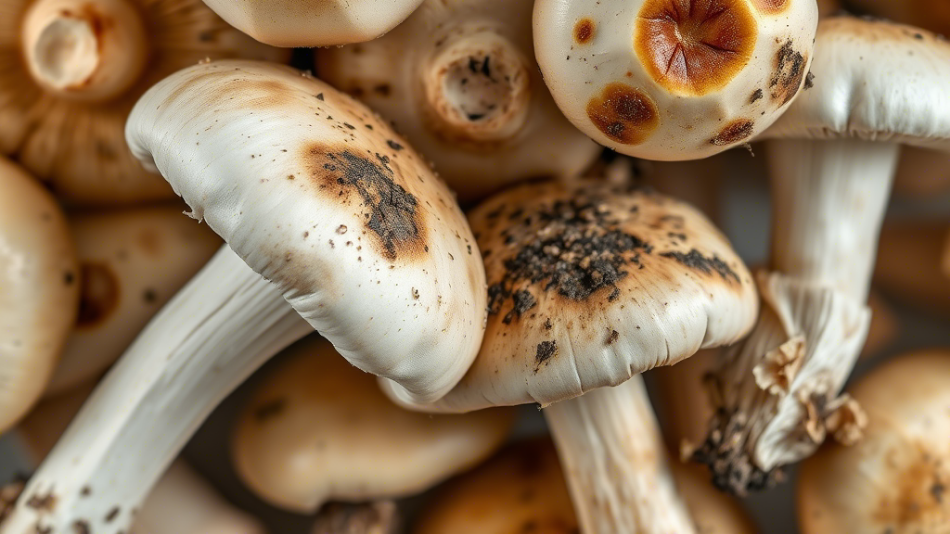For mushroom growers and mycology enthusiasts, Pseudomonas represents one of the most insidious and persistent adversaries. This guide was born from the need to provide a scientific yet practical approach to managing this bacterial disease, combining academic research with the field experience of expert growers. In recent years, the incidence of Pseudomonas bacterial disease has increased significantly, due to climate change and the intensification of cultivation. According to data from the EFSA, over 35% of production losses in cultivated mushrooms are attributable to bacterial infections, with Pseudomonas being one of the main culprits. Through this comprehensive guide, we will explore not only how to combat Pseudomonas bacterial disease but, more importantly, how to create an ecosystem unfavorable to its development, thereby ensuring the health of your crops and the quality of your mushrooms. Before tackling any pathogen, it is essential to understand its biology, ecology, and virulence mechanisms. Pseudomonas is no exception—in fact, its extraordinary adaptability makes it particularly formidable. The genus Pseudomonas belongs to the family Pseudomonadaceae and includes over 200 species. In mushroom cultivation, the most problematic species are: A study published in the Journal of Applied and Environmental Microbiology demonstrated that these species can develop cross-resistance to various antibacterial compounds, making an integrated approach essential. Pseudomonas exerts its pathogenic action through several mechanisms: Pseudomonas is a ubiquitous bacterium that can survive in various environments: Research conducted by the USDA Agricultural Research Service highlighted that some strains can enter a dormant state under adverse conditions, reactivating when the environment becomes favorable again. Identifying a Pseudomonas infection early can make the difference between effective treatment and an uncontrollable outbreak. This section will guide you through clinical signs, diagnostic techniques, and common mistakes to avoid. The infection manifests with a characteristic progression: Beyond visual observation, more precise methods exist: For a definitive diagnosis, specialized laboratories use: The British Mycological Society offers diagnostic services and consultations for professional growers. The battle against Pseudomonas is won primarily through rigorous prevention. In this section, we will explore how to transform your cultivation environment into a resilient system that minimizes infection risks. The physical layout of cultivation can significantly influence bacterial risk: A study by the EPA shows that proper laminar airflow can reduce contamination by up to 70%: Standardizing procedures is crucial: When prevention is not enough, it is essential to have a wide range of therapeutic options. This section critically analyzes each approach, highlighting advantages, limitations, and optimal application methods. Nature offers powerful allies against Pseudomonas: According to research from the RIKEN Institute, the following strains show efficacy: Some plants contain compounds active against Pseudomonas: An innovative frontier in the fight against Pseudomonas bacterial disease is the targeted application of LED light at specific wavelengths. Recent studies published in the Journal of Photochemistry and Photobiology demonstrate that particular light spectra can selectively inhibit pathogenic bacteria without harming mushrooms. Here are the most promising combinations: A study by the FDA shows that: Research by the USDA suggests combined protocols: To correctly implement phototherapy: A 2023 study in Applied Microbiology and Biotechnology demonstrated that the combined use of blue (450nm) and green (520nm) LEDs in pulsed intervals can reduce bacterial load by 99.7% without altering mycelial growth. Important Note: effectiveness varies depending on the fungal species cultivated. Preliminary small-scale tests are recommended, monitoring for any phototoxicity. For commercial cultivation, consult professional LED systems with customizable spectrograms. Combating Pseudomonas bacterial disease requires a paradigm shift: from simple eradication to creating a resilient ecosystem where pathogens struggle to establish themselves. The most advanced growers are adopting an approach that integrates: Cultivations adopting these principles report an 80% reduction in Pseudomonas infections, with a parallel increase in productivity and quality. Remember: every cultivation is a unique system requiring observation, adaptation, and patience. With the right knowledge and a methodical approach, Pseudomonas bacterial disease can be effectively controlled, allowing you to achieve abundant, high-quality harvests. The fungal kingdom is a universe in continuous evolution, with new scientific discoveries emerging every year about their extraordinary benefits for gut health and overall well-being. From now on, when you see a mushroom, you will no longer think only of its taste or appearance, but of all the therapeutic potential it holds in its fibers and bioactive compounds. ✉️ Stay connected - Subscribe to our newsletter to receive the latest studies on: Nature offers us extraordinary tools to take care of our health. Fungi, with their unique balance between nutrition and medicine, represent a fascinating frontier we are only beginning to explore. Continue to follow us to discover how these extraordinary organisms can transform your approach to well-being.Pseudomonas: an adversary to understand thoroughly
Taxonomy and pathogenic species
Pathogenicity mechanisms
Mechanism Effect Compound Involved Toxin production Cell lysis and tissue necrosis Tolaasin, Syringomycin Biofilm formation Protection from treatments Exopolysaccharides Iron competition Deprivation of essential nutrients Siderophores (pyoverdine) Ecology and life cycle
Early diagnosis: recognizing warning signs
Macroscopic symptoms
Initial stage (24-48 hours)
Advanced stage (3-5 days)
Diagnostic techniques
Home tests
Laboratory analysis
Prevention: building an impregnable fortress
Environment design
Zoning
Airflow
Operational protocols
Operation Frequency Protocol Surface disinfection Daily 3% hydrogen peroxide Tool sterilization Pre/post use Dry heat at 180°C for 30' Environmental monitoring Weekly Sedimentation plates
Therapeutic arsenal: from tradition to science
Biological approaches
Antagonistic microorganisms
Botanical extracts
Plant Active Compound Effective Concentration Melaleuca alternifolia Terpinen-4-ol 0.5-1% in solution Allium sativum Allicin 2-5% in fresh extract Antimicrobial phototherapy: the strategic use of LED light against Pseudomonas
Effective lighting protocols
Blue LED (415-455 nm)
Violet LED (405 nm)
UV-C Light
Synergistic combinations
Phase Spectrum Duration Purpose Prevention Cool white (5000K) + Blue 12h/day Create hostile environment Treatment Violet + Far red (730nm) Cycles 1h/3h Selective bacterial stress Practical considerations
Pseudomonas: toward holistic management
Continue your journey into the world of fungi
Cookies help us deliver our services. By using our services, you agree to our use of cookies. Learn more










